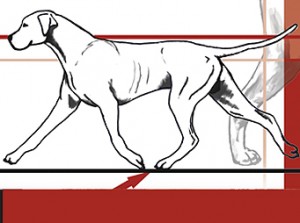Examination of Movement in Dogs – Bridging the Gap
172 – October, 2017
by Deborah Andoetoe
PART THREE – BRIDGING THE GAP
 The first article in this series dealt with the hindquarters, the second with the front assembly. Now we need to bridge the gap between the two. For it is the design of this bridge which provides the outline of the dog which is often one of the most recognizable components of breed type. The bridge is comprised of the head, neck, withers, back, loin, sacrum and coccyx or tail. The ribs and belly muscles are an integral part of the bridge and provide the foundation on which the rest relies.
The first article in this series dealt with the hindquarters, the second with the front assembly. Now we need to bridge the gap between the two. For it is the design of this bridge which provides the outline of the dog which is often one of the most recognizable components of breed type. The bridge is comprised of the head, neck, withers, back, loin, sacrum and coccyx or tail. The ribs and belly muscles are an integral part of the bridge and provide the foundation on which the rest relies.
Because the hindquarters are attached to the bridge through a hard point of contact, the pelvis, thrust provided by the hind legs drives straight through the bridge. The hindquarters shape the energy of the dog, energy shapes the outline and determines movement, self carriage, and balance.
The front assembly is attached to the bridge by muscles and connective tissue. This soft connection can be adjusted by proper conditioning, but exercise will only raise the chest higher between the scapulae, effectively lifting the dorsal processes of the spine in the withers. This is an adjustment in conditioning, not in the lay-on or in the lay-back of the shoulder.
The lay-on of the shoulder is how the topmost ridge of the shoulder attaches to the bridge. This includes the thickness of the shoulder muscles as well as the distance between the shoulder blades and where they connect to the thoracic vertebrae of the spine. The lay- back is an integral part of the design of the shoulder blade and should include the concept of the plumb- line and the actual design of the front assembly rather than simply the lay-back of the scapula.
There are a couple of points of interest which are misunderstood about the topline. The first is that the topline is not simply the dog’s back. The true back is part of the topline as are the loin, withers, and croup. The pelvis holds a special function as it is part of both the topline and the hindquarters, connected to both by joints. The pelvis allows energy generated by the hindquarters to travel into the body. The angle of the pelvis affects the way a dog engages his hindquarters and how much energy travels upwards versus the energy that travels straight forward. This directly affects suspension.
Click here to read the complete article172 – October, 2017
Short URL: https://caninechronicle.com/?p=133736
Comments are closed











